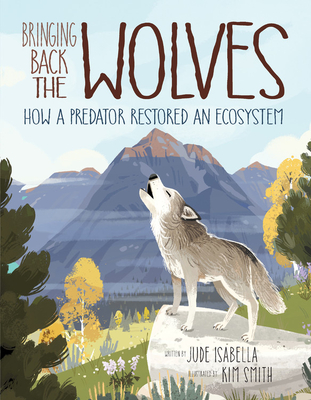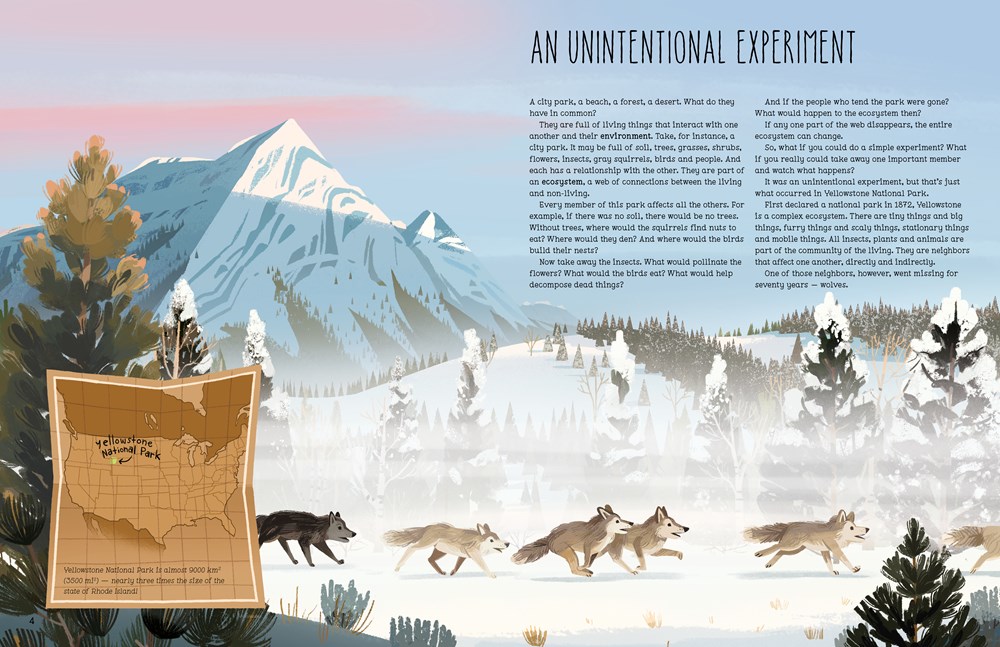
Bringing Back the Wolves: How a Predator Restored an Ecosystem – Jude Isabella and Kim Smith (ill.) – Kids Can Press – Published 3 March 2020
♥♥♥♥♥
Synopsis
An unintended experiment in Yellowstone National Park, in which an ecosystem is devastated and then remarkably rehabilitated, provides crucial lessons about nature’s intricate balancing act.
In the 1800s, hunters were paid by the American government to eliminate threats to livestock on cattle ranches near Yellowstone National Park. They did such a good job that, by 1926, no gray wolf packs were left in the park. Over the following decades, virtually every other part of the park’s ecosystem was affected by the loss of the wolves — from the animals who were their prey, to the plants that were the food for that prey, to the streams that were sheltered by those plants — and the landscape was in distress. So, starting in 1995, in an attempt to reverse course, the government reintroduced gray wolves to the park. Over time, animal populations stabilized, waterways were restored and a healthy ecosystem was recreated across the land. It’s a striking transformation, and a fascinating tale of life’s complicated interdependencies.
My thoughts
Bringing Back the Wolves – How A Predator Restored An Ecosystem explains about the history of the wolf in the Yellow Stone National Park in the US. From the hunting of wolves in the 1800s and the result this had on the Park to the reintroduction of wolves in 1995, this book explores the impact of an apex predator and how the Park has changed since the wolves have returned.
 There is a wonderful sense of nature fixing its self as this book clearly steps out the impact of the wolves. Bringing Back the Wolves does a fantastic job of clearly and simply articulating the complex relationships involved and the intricacies of the impacts.
There is a wonderful sense of nature fixing its self as this book clearly steps out the impact of the wolves. Bringing Back the Wolves does a fantastic job of clearly and simply articulating the complex relationships involved and the intricacies of the impacts.
The illustrations are delightfully beautiful. Despite this book being about predators and prey, hunting and killing for food, the illustrations are nicely sanitised. There are wolves howling, running, watching, and even standing in a tight circle around something you can’t see, but there are no images of blood, carcasses, dead or injured animals, or of the hunt itself. This makes this book appealing to younger children or more sensitive readers, without shying away from the facts. Food chains and webs are used to highlight the prey and predator relationship. The illustrations are full colour, using soft and vibrant tones to bring the animals, trees, and backdrop to life. Some pages have the illustration sitting on the next page, others are full spread images with the text integrated into the picture. There are also illustrated call-out boxes that feature interesting facts or further explain how the ecosystem works.
T here is a lot of text in this book. The book reads a little like a story and flows from one page to the next, with hooks to keep the reader engaged and help the information flow to the next page. This gives the book a more story-like feel, rather than traditional non-fiction text. The writing is evocative and aptly conveys the importance of each part of the ecosystem. Headings and information boxes are still used to help readers find their way through and back to the information they might be seeking, but the book is best read from cover to cover.
here is a lot of text in this book. The book reads a little like a story and flows from one page to the next, with hooks to keep the reader engaged and help the information flow to the next page. This gives the book a more story-like feel, rather than traditional non-fiction text. The writing is evocative and aptly conveys the importance of each part of the ecosystem. Headings and information boxes are still used to help readers find their way through and back to the information they might be seeking, but the book is best read from cover to cover.
The book includes a thorough glossary and index, as well as resources for further reading.
A beautiful and important book that illustrates and explains the importance of the natural order of ecosystems and the role apex predators.
The publishers provided an advanced readers copy of this book for reviewing purposes. All opinions are my own.
More information
Category: Children’s non-fiction
Subjects: Apex predators, animals, wolves, science, nature, ecosystems, nature, conservation, protection, food webs
Reading age guide: Ages 8-12
Format: Hardcover, ebook. 40 pages.
Published: 3 March 2020 by Kids Can Press
ISBN: 9781771386258


Leave a Reply